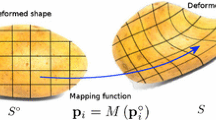Abstract
Shape from texture is best analyzed in two stages, analogous to stereopsis and structure from motion: (a) Computing the ‘texture distortion’ from the image, and (b) Interpreting the ‘texture distortion’ to infer the orientation and shape of the surface in the scene. We model the texture distortion for a given point and direction on the image plane as an affine transformation and derive the relationship between the parameters of this transformation and the shape parameters. We have developed a technique for estimating affine transforms between nearby image patches which is based on solving a system of linear constraints derived from a differential analysis. One need not explicitly identify texels or make restrictive assumptions about the nature of the texture such as isotropy. We use non-linear minimization of a least squares error criterion to recover the surface orientation (slant and tilt) and shape (principal curvatures and directions) based on the estimated affine transforms in a number of different directions. A simple linear algorithm based on singular value decomposition of the linear parts of the affine transforms provides the initial guess for the minimization procedure. Experimental results on both planar and curved surfaces under perspective projection demonstrate good estimates for both orientation and shape. A sensitivity analysis yields predictions for both computer vision algorithms and human perception of shape from texture.
Similar content being viewed by others
References
Aloimonos, J. 1988. Shape from texture. Biological Cybernetics, 58:345-360.
Bajcsy, R. and Lieberman, L. 1976. Texture gradient as a depth cue. CGIP, 5:52-67.
Blake, A. and Marinos, C. 1990. Shape from texture: Estimation, isotropy and moments. Artificial Intelligence, 45:323-380.
Blake, A., Bulthoff, H., and Sheinberg, D. 1993. Shape from texture: Ideal observers and human psychophysics. Vision Research, 33(12):1723-1737.
Blostein, D. and Ahuja, N. 1989. Shape from texture: Integrating texture-element extraction and surface estimation. IEEE Trans. on PAMI, 11(12):1233-1251.
Brown, L. G. and Shvaytser, H. 1990. Surface orientation from projective foreshortening of isotropic texture autocorrelation. IEEE Trans. on PAMI, 12(6):584-588.
Cutting, J. and Millard, R. 1984. Three gradients and the perception of flat and curved surfaces. Journal of Experimental Psychology: General, 113(2):198-216.
Davis, L. S. Janos, L., and Dunn, S. M. 1983. Efficient recovery of shape from texture. IEEE Trans. on PAMI, 5(5).
Do Carmo, M. P. 1992. Riemannian Geometry. Boston: Birkhauser.
Gårding, J. 1992. Shape from texture for smooth curved surfaces in perspective projection. Journal of Mathematical Imaging and Vision, 2(4):327-350.
Gårding, J. 1993. Shape from texture and contour by weak isotropy. J. of Artificial Intelligence, 64(2):243-297.
Gibson, J. 1950. The Perception of the Visual World. Boston: Houghton Mifflin.
Ikeuchi, K. 1984. Shape from regular patterns. J. of Artificial Intelligence, 22:49-75.
Jones, D. and Malik, J. 1992. Determining three-dimensional shape from orientation and spatial frequency disparities. Proc. of the Second ECCV, pp. 661-669.
Kanatani, K. and Chou, T. C. 1989. Shape from texture: General principle. J. of Artificial Intelligence, 38:1-48.
Koenderink, J. 1990. Solid Shape. Cambridge, Mass.: MIT Press.
Krumm, J. and Shafer, S. 1992. Shape from periodic texture using the spectrogram. Proc. CVPR, Champaign-Urbana, Illinois, pp. 284- 301.
Lindeberg, T. and Gårding, J. 1993. Shape from texture from a multiscale perspective. Proc. ICCV, Berlin, Germany, pp. 683-691.
Malik, J. and Rosenholtz, R. 1993. A differential method for computing local shape-from-texture for planar and curved surfaces. Proc. of IEEE CVPR, New York, pp. 267-273.
Malik, J. and Rosenholtz, R. 1994. Recovering surface curvature and orientation from texture distortion: A least squares algorithm and sensitivity analysis. Proc. of Third European Conf. on Computer Vision, Stockholm, published as Lecture Notes in Computer Science, vol. 800, Jan-Olaf Eklundh (Ed.), Springer Verlag, pp. 353-364.
Marinos, C. and Blake, A. 1990. Shape from texture: The homogeneity hypothesis. Proc. ICCV, Osaka, Japan, pp. 350-353.
Marks, R. J. 1991. Introduction to Shannon Sampling and Interpolation Theory. Springer-Verlag.
O'Neill, B. 1966. Elementary Differential Geometry. New York: Academic Press.
Press, W. H., Flannery, B. P., Teukolski, S. A., and Vetterling, W. T. 1988. Numerical Recipes in C. Cambridge University Press.
Rousseeuw, P. J. and Leroy, A. M. 1987. Robust Regression and Outlier Detection. Wiley.
Stevens, K. A. 1981. The information content of texture gradients. Biological Cybernetics, 42:95-105.
Super, B. and Bovik, A. 1995. Shape from texture using local spectral moments. IEEE Trans. on PAMI, 17(4):333-343.
Verri, A., Girosi, F., and Torre, V. 1990. Differential techniques for optical flow. Journal of the Optical Society of America A, 5:912- 922.
Witkin, A. P. 1981. Recovering surface shape and orientation from texture. J. of Artificial Intelligence, 17:17-45.
Author information
Authors and Affiliations
Rights and permissions
About this article
Cite this article
Malik, J., Rosenholtz, R. Computing Local Surface Orientation and Shape from Texture for Curved Surfaces. International Journal of Computer Vision 23, 149–168 (1997). https://doi.org/10.1023/A:1007958829620
Issue Date:
DOI: https://doi.org/10.1023/A:1007958829620




